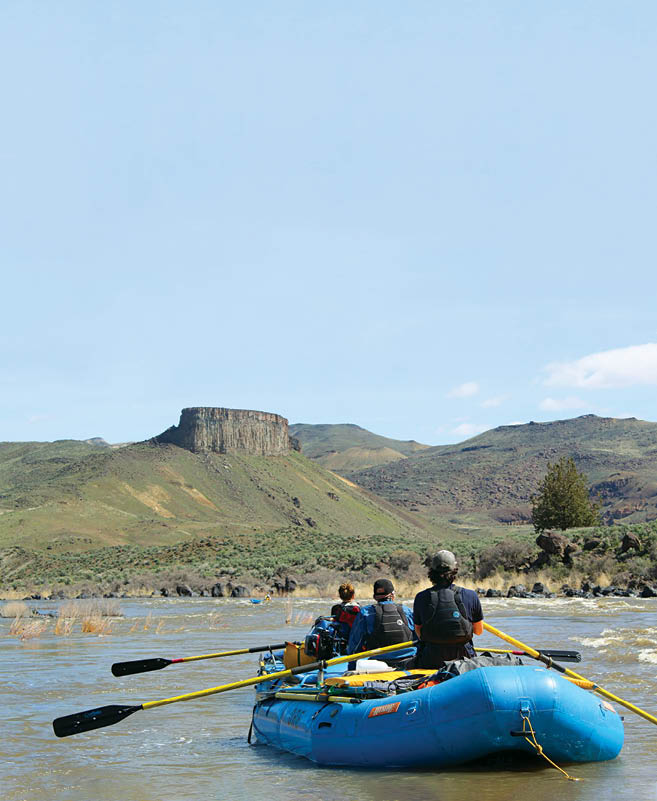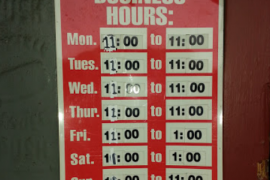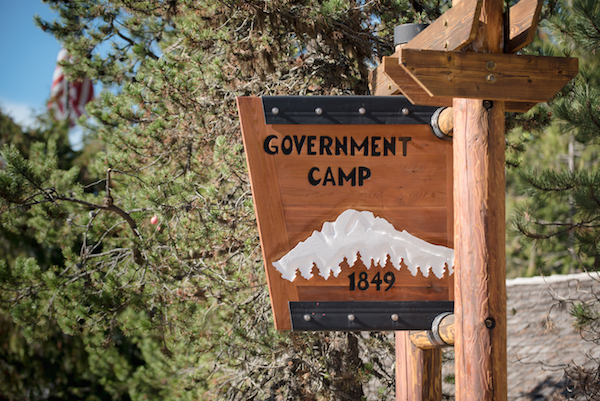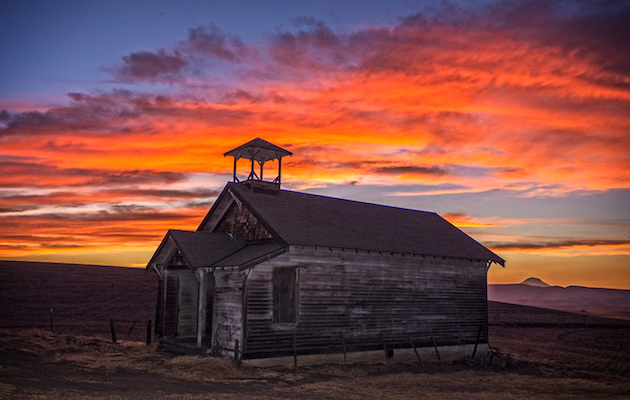Travel through time in a land of legends
written and photographed by Adam Thorn Smith
Outdoorsy Portlanders love to say “every environment is an hour away!” But, what if we went farther? What if we went … all the way? There is a place in our state—an inexplicable convolution of time and rock—where a river spills like mercury through the heart of an ancient supervolcano. Hot springs still steam with hidden heat. Relics lie lost in caves. Legends are born and die here, some never told.
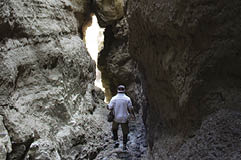
Exploring a slot canyon.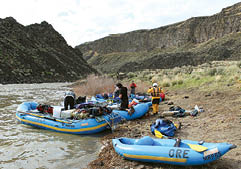
The group breaks for lunch on the first day of the trip.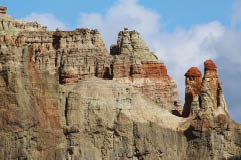
For many years, unique formations served as landmarks and were often sacred to tribes such as the Shoshone and Bannock.
Oregon’s loneliest corner and most remote region, the extreme southeast, is seven hours and 400 miles from Portland. To most imaginations, southern Malheur County must be a bland expanse of tumbleweed and juniper, the rare hare or coyote, somewhere past Steens Mountain. In truth, earth-bending natural wonders and geologic monoliths abound. People who venture here, by luck or lack thereof, are as unusual as the place itself.
Sixteen million years ago, the Yellowstone hotspot was here, erupting endlessly. Massive upwellings of ash and magma built the bedrock—each layer recording its composition like tree rings—now exposed to modern science in the canyon cliffs and eroding silt stacks that tower around every turn. Add eons of tectonics, volcanism, inland seas, ice ages, earthquakes, floods and landslides, and you have an ever-changing world of rock so twisted and complex it often hides its own history. Through these formations, the Owyhee River runs—a highly coveted journey in the diaries of whitewater enthusiasts. And naturalists. And historians. And Oregonians. I was thrilled.
It was early April. Nevada and Idaho snowmelt made the river bulge to requisite rafting levels—a brief window each spring—for the 65-mile trip, from the put-in at Rome to Leslie Gulch.
Seated backward on the bow, camera in hand, I marveled at the pale pillar-like precipices—the same chalky columns that reminded settlers of the Colosseum, inspiring the town’s name—as we slowly floated by. I was traveling with Oregon River Experiences, a professional outfitter for four decades, on its first Owyhee trip of 2019.
Day one, midway, our rubber fleet eddied out on a sandy beach. The eight of us disembarked the six boats—
four oared gear rafts, a cataraft and inflatable kayak. We took our first steps inside Owyhee Canyon, with five exhilarating days of rapids, hikes and hot springs ahead. Turning slowly, we gawked at the rock walls, booties sloshing but warm in our wetsuits, and loosened our personal floatation devices. Six million years of geology began here, passing at 100,000 years per river mile.
“Lunch time!” called out Ted Browning, ORE’s senior guide. In a blink, he and the crew readied a tabletop spread of turkey wraps, veggies, chips and cookies.
As we ate, I asked the older couple—fellow Owyhee rookies—why they chose this expedition. “We’ve been dreaming of an Owyhee trip for decades,” they said, raising my interest. I soon learned they were whitewater masters, with a hundred river runs for every wrinkle. “We could’ve outfitted ourselves, but it’s so remote, we decided to go commercial. Plus, we’re old,” they said, justifying the luxury. The other party members included three younger guides and a company friend, each as interesting as the next.
Throughout history, humans here are few and far between, often as mysterious as the landscape. Since time immemorial, nomadic Paiute Indians lived here, leaving behind prehistoric art, arrowheads and artifacts. In 1820, three scouts for the Northwest Fur Company were mysteriously murdered here. They were from Hawaii, and their demise dubbed the river, as originally spelled. Sacagawea’s son, Jean-Baptiste Charbonneau, an infant with Lewis & Clark in 1805, returned sixty years later only to perish from pneumonia after crossing the frigid Owyhee. He was among hordes of fortune hunters who came for gold and silver in the 1860s. Eventually, newcomers and natives clashed in the Snake War, 1864 to1868, leaving hundreds dead or sent to reservations. As mines went dry, cattle ranchers replaced prospectors, including Basque sheepherders from northern Spain whose imprint is still visible in the pelota courts of nearby Jordan Valley. And with livestock came the rustlers—gunslinging outlaws with camps and corrals cleverly hidden in the sagebrush and wheatgrass gullies—who knew every secret spring, cavern, and river ford in “Oregon’s Grand Canyon.”
We floated on, oars churning the turbid water, reading the water ahead. Each day we bashed big waves too, sections such as Bullseye, Squeeze, and Whistling Bird—exciting Class III-IV rapids. Midday, we stopped for land adventures: searching the sediment slots of Lambert Rocks, finding a rustler’s hideout in Iron Point, pondering a boulder field of Stone Age petroglyphs, and always scanning for bighorn, antelope, bobcat or cougar.
Then, we’d paddle on, until the next campsite appeared under marvelous new walls. Afternoons, we might hike a ridge, explore a cave, listen for meadowlarks on a wildflower walk, or just unfold a chair with a pair of binoculars, a good book or banjo. At dusk, we enjoyed delicious hot dinners, desserts and drinks around a flickering fire, telling stories and stargazing. At dawn, the feast would repeat, with coffee and breakfast before another glorious day of whitewater rafting.
Late one night, just before moonrise, I slipped from camp and eased into a thermal pool, laying back to look at the stars, waiting for the lunar beams to dance with the ancient rock—above my misty bath, by a river, in a volcano. Once risen, the full moon looked like a marble rolling down the clifftop.
As I soaked, I tried to soak it all in, because nowhere else in Oregon, or on Earth, is the world quite like this.


